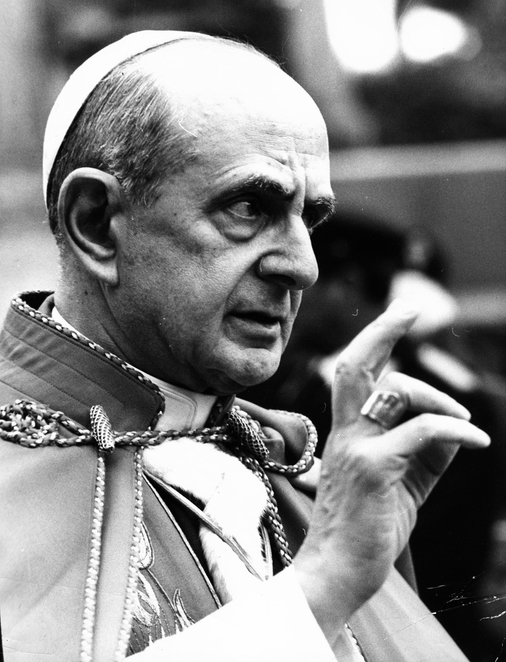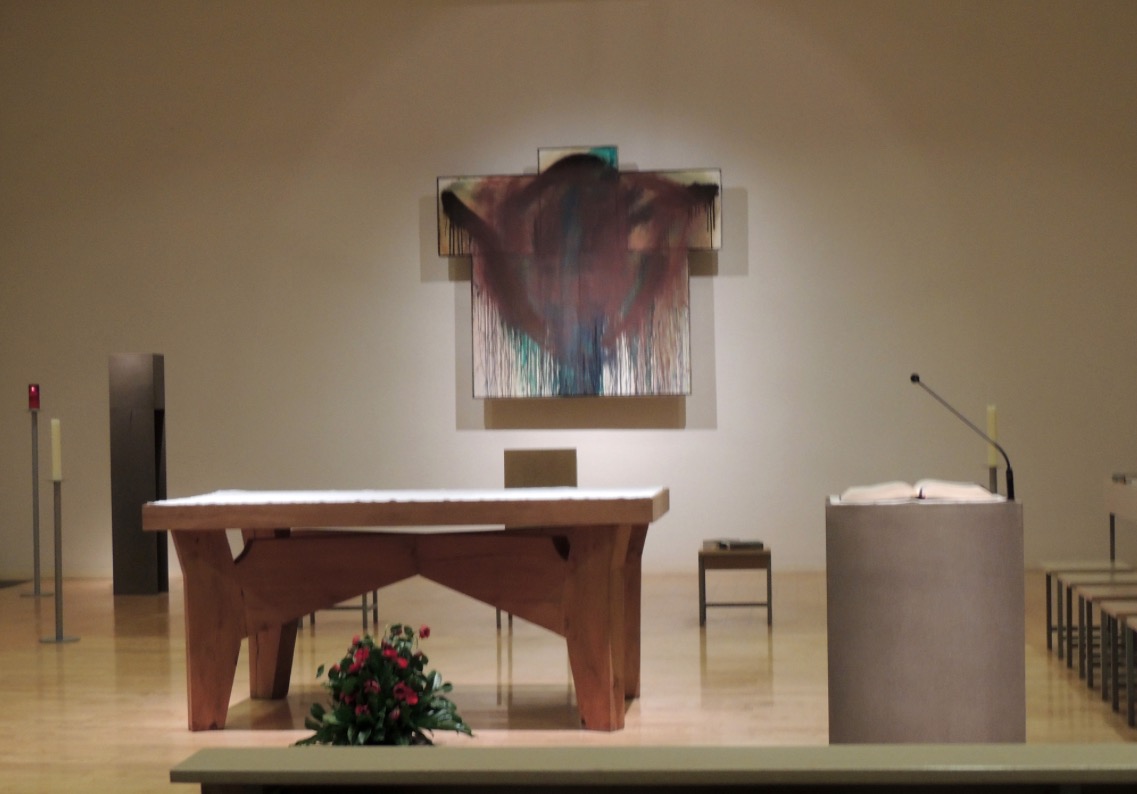A frightening thought!
False Pope Paul VI to Lay Leaders in 1966: Transform Yourselves “into the Image of the Conciliar Church”!

(Image: © KEYSTONE Pictures USA / used with permission)
It is often thought that the first appearance of the term “Conciliar Church” was in 1976, when “Archbishop” (later “Cardinal”) Giovanni Benelli, then the Vatican’s Substitute Secretary of State, wrote in a letter to Abp. Marcel Lefebvre, founder of the traditionalist Society of St. Pius X (SSPX):
Do not use as a pretext the confused state of the seminarians who were to be ordained: this is just the opportunity to explain to them and to their families that you cannot ordain them to the service of the Church against the will of the supreme Pastor of the Church. There is nothing desperate in their case: if they have good will and are seriously prepared for a presbyteral ministry in genuine fidelity to the Conciliar Church. Those responsible will find the best solution for them, but they must begin with an act of obedience to the Church.
(Bishop Giovanni Benelli, Letter to Archbishop Marcel Lefebvre, June 25, 1976; reprinted here. Underlining added.)
Benelli was hoping to dissuade Abp. Lefebvre from ordaining priests for his Society — a task that would prove to be unsuccessful.
A few weeks prior, Lefebvre had given a speech in the United States in which he reaffirmed his complete opposition to the Modernist Second Vatican Council (1962-65):
In his attempt to reconcile the traditional Catholic doctrine on the indefectibility and infallibility of the Catholic Church with Vatican II’s undeniable defection, this idea of a “Conciliar Church” came in very handy for the retired French archbishop, because it allowed him to ascribe all the errors of the council and the post-conciliar magisterium to the “Conciliar Church”, while anything that was still Catholic could be attributed to the true Catholic Church.
The problem was that according to this theory, the men Lefebvre recognized as as the official Catholic hierarchy were somehow hierarchs over both churches, exercising their authority at times over the one, at times over the other institution — much like a ventriloquist who sometimes speaks as his own self and sometimes as the puppet he holds — but with no a priori way of telling when they were engaging in which activity. That was something to be determined a posteriori, that is, by critically examining the acts of their magisterium and their government, not excepting the (supposed) Pope himself. And for that, the laity were to turn to the Society of St. Pius X.
That such an idea is utterly incompatible with the traditional Catholic doctrine on the Church should be so obvious as not to require any proof. It was in fact none other than Pope St. Pius X (r. 1903-1914), the patron saint Lefebvre had picked for his priestly fraternity, who reaffirmed genuine Catholic doctrine when he declared that “the first and greatest criterion of the faith, the ultimate and unassailable test of orthodoxy is obedience to the teaching authority of the Church, which is ever living and infallible…” (Address Con Vera Soddisfazione, May 10, 1909).
That the Vatican II religion comes with a whole new church, as it were, can readily be granted — the council did, after all, redefine the very nature of the Church in its dogmatic constitution Lumen Gentium (n. 8), and this was happily admitted by “Cardinal” Karol Wojtyla, the future “Pope” John Paul II, in his 1977 book Sign of Contradiction.
Whether we want to call this strange new entity that teaches the Vatican II religion the “Conciliar Church”, or perhaps the “Novus Ordo Church”, the “Vatican II Sect”, or something similar, is of secondary importance. In fact, the first publicly sedevacantist priest, the Mexican Fr. Joaquin Saenz y Arriaga (1899-1976), called it the “Montinian Church”, as “Pope” Paul VI’s real name was Giovanni Battista Montini, and he wrote a whole book about it called The New Post-Conciliar or Montinian Church (622 pages; first published in 1972; purchase through this link benefits Novus Ordo Watch).
In all fairness, however, and for the record, we must point out that not all sedevacantists are in agreement that we should properly be speaking of a separate church. Bishop Donald Sanborn explains his position here:
In any case, what is clear from Catholic doctrine is that “the Mystical Body of Christ and the Roman Catholic Church are one and the same thing” (Pope Pius XII, Encyclical Humani Generis, n. 27), so any idea according to which the true Roman Catholic hierarchs can direct a false church to which everyone who is subject to them (as he must be) unwittingly attaches himself automatically, is wholly absurd. It completely destroys the very purpose of having a visible hierarchy in communion with the Pope to begin with and in fact renders such a set-up a grave spiritual danger.
As Pope Pius XII noted: “Christ founded his Church not in the nature of some unformed spiritual movement, but as a solidly organized society” (Allocution Wir Heissen Sie, June 3, 1956). But what would be the purpose of that organized society if by sincerely adhering to it one cannot be certain that one will be safely led into truth and holiness? Who needs an organized society that is capable of speaking both salvific truth and infernal error, that may send one to Heaven one day and to hell the next? How is such an organized society “the pillar and ground of the truth” (1 Tim 3:15)? How is such a church “subject to Christ” (Eph 5:24), indeed “a glorious church, not having spot or wrinkle, or any such thing; but … holy, and without blemish” (Eph 5:27)? How in fact would such an institution differ in essence from, say, the Anglican Church, or the Methodist Church?
At the very end of his long pontificate, Pope Pius IX praised the president of the Italian Catholic Youth Council because he knew that by following “not only the orders, but even all the directives of the Apostolic See … you cannot be deceived or betrayed” (Letter Didicimus Non Sine; excerpted in Papal Teachings: The Church, n. 439).
No, a “Conciliar Church” certainly will not fit into traditional Catholic doctrine, which Abp. Lefebvre, ironically, nevertheless saw himself as defending.

No, it’s not vandalism: This blasphemous “crucifix” is found in a seminary chapel of the Conciliar Church in Austria
(image source: austria-forum.org, Werner Gobiet/fair use)
As it turns out, however, the term “Conciliar Church” was not first used in 1976 by Bp. Benelli. As far as we have been able to determine, the expression was first used ten years earlier by none other than “Pope” Paul VI (r. 1963-1978) himself. In his closing speech for the last session of the council, on Dec. 7, 1965, Paul VI had already spoken of “the Church of the council”, but did not then use the term “conciliar Church”.
In an address given to lay leaders on Mar. 8, 1966, exactly three months after the close of the infernal council, Paul VI said:
For it is not a matter merely of collecting and spreading the council’s teachings, but of transforming oneself into the image of the conciliar Church [l’Eglise conciliaire], renewed in its prayer, in the expression of its faith and its hope and in the clarity of its dialogue with all Christians and all men. In that way each Catholic will be able to help his brother believe in Christ and to recognize Him in His Church.
(Antipope Paul VI, Address to Members of the Permanent Committee of the International Congresses for the Apostolate of the Laity, Mar. 8, 1966; underlining added. Translation taken from The Messenger, Mar. 18, 1966, p. 3.)
So here we see the founder of the Novus Ordo religion, the false pope Paul VI, assert the importance of “transforming oneself into the image of the conciliar Church” — a frightful thought!
It is now 56 years later. What “image” does one see in the Conciliar Church? Is it recognizably that of Jesus Christ, that of His Mystical Body? Or is it not rather that of apostate man, who “has with infinite temerity put himself in the place of God, raising himself above all that is called God” (Pope Pius X, Encyclical E Supremi, n. 5) and thus constitutes, as it were, a sort of mystical body of the Antichrist? To ask the question is to answer it.
In 1971, five years after first using the term “Conciliar Church”, Paul VI remarked that the painting with the title “Papacy” that artist Ernst Günter Hansing had made for him was “a mirror of the situation in the Church today”. And he was right.
If you’ve never seen it, be sure to take a look at the true image of the “Conciliar Church”.
It’s practically a photograph.
Title image source: alamy.com (Keystone Press / Alamy Stock Photo)
License: rights-managed



No Comments
Be the first to start a conversation